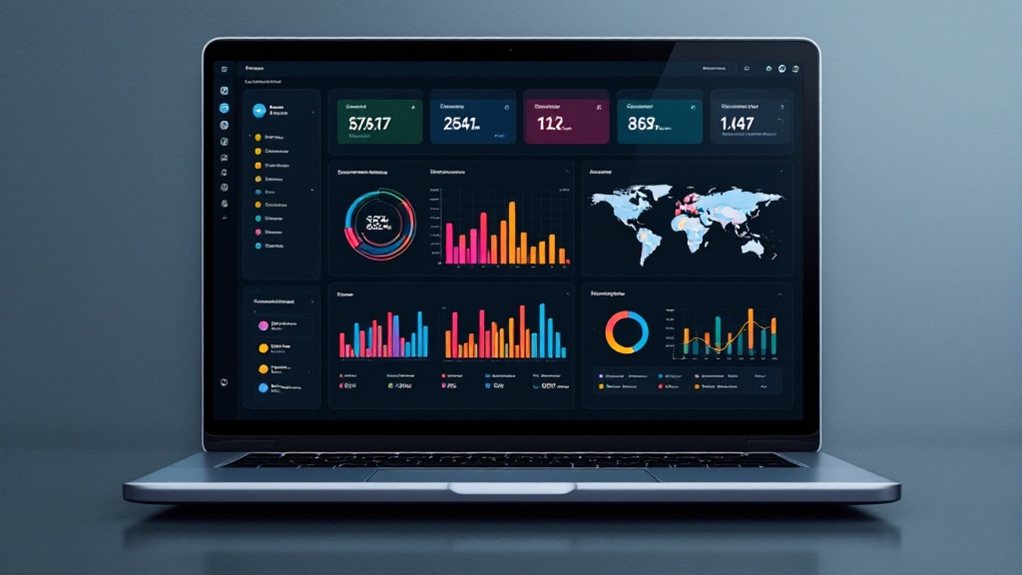To analyze geo-specific content performance, you'll want to leverage location data to tailor your marketing strategies. Track key metrics like click-through rates, conversion rates, and engagement levels across regions to identify high-performing areas. Optimize your campaigns by refining bidding strategies, prioritizing user intent, and continuously analyzing the incremental impact. Additionally, applying spatial analysis techniques and demographic segmentation can uncover localized behavioral insights to further enhance your content performance. Keep reading to dive deeper into these methods.
Leveraging Geolocation Data

While geolocation data may seem like a complex topic, it offers numerous benefits that can significantly enhance your content performance. By leveraging this data, you can tailor your content and services to users' locations, improving engagement and user experience. Customizing marketing strategies based on target audience's geographic locations can allow for more efficient use of advertising budget through targeted campaigns. Targeted marketing and content localization ensure your offerings are relevant to specific demographics, boosting conversion rates. Geolocation also optimizes your network services and logistics, enhancing efficiency. Moreover, it provides valuable insights into user behavior, market dynamics, and operational strategies, empowering you to make data-driven decisions. As you harness the power of geolocation data, be mindful of privacy considerations to ensure compliance and maintain user trust.
Interpreting Engagement Metrics

Interpreting engagement metrics is crucial for understanding the effectiveness of your geo-targeted content. Carefully analyze key metrics like click-through rates (CTRs), conversion rates, and reach to gain valuable insights. High CTRs indicate your content resonates with local audiences, while conversion rates quantify the success of your campaigns. Monitor how engagement levels, such as likes, shares, and comments, vary across regions to identify high-performing areas. Additionally, reviewing cost per conversion can help optimize your marketing budget for better ROI. Understanding local audience behavior is key to leveraging these insights. Leverage platforms like Google Analytics to uncover regional data patterns and guide your content adjustments. This data-driven approach ensures your geo-targeting strategies continuously deliver meaningful results.
Evaluating Conversion Rates

Evaluating conversion rates is a crucial step in assessing the effectiveness of your geo-targeting efforts. Tailoring content to match local preferences enhances its relevance, leading to higher conversion rates. Additionally, using location-specific keywords improves visibility in local search results, attracting more qualified traffic. Crafting content that appeals to specific geographic areas also increases trust and conversion rates. To measure success, key metrics for geo-targeting include:
- Conversion rates
- Engagement levels
- Analyzing geo-targeting data to reveal insights into successful campaign characteristics.
Continuous optimization based on these insights will aid in driving future performance. [Leveraging location-specific targeting can also help maximize marketing budgets by focusing efforts on the most relevant audience.
Optimizing Cost-Efficiency
To optimize cost-efficiency, you can focus on maximizing your return on advertising spend by refining your bidding strategies. Additionally, leveraging localized insights can help you allocate resources more effectively. Generative Engine Optimization (GEO) prioritizes user intent and context to streamline your content optimization efforts while driving better results.
Return on Advertising Spend
Optimizing ad spend is crucial for driving cost-efficiency in your marketing efforts. To measure the return on your advertising spend (ROAS), focus on tracking key metrics like revenue, conversions, and incremental impact. Geo-targeted ads allow you to connect with specific local audiences and measure their impact on your overall marketing performance.
- Measure the revenue generated from geo-targeted ads and compare it to their costs to calculate ROAS.
- Analyze the incremental impact of ads in different regions to ensure your investments drive meaningful revenue.
- Use multi-touch attribution models to accurately attribute conversions across multiple touchpoints for a comprehensive view of ad effectiveness.
Refine Bidding Strategies
When refining your bidding strategies, closely monitor the cost per conversion to make adjustments that maximize your return on investment. Use location-based bidding to focus on high-performing regions, and segment audiences by location to tailor bids to specific demographics and behaviors. Regularly analyze geo-targeting data to identify high-performing locations and those that require a change in strategy. Optimize ad placement in regions with high engagement and conversion rates, and leverage real-time bidding platforms to dynamically adjust bids based on location data. Analyze conversion rates, click-through rates, and engagement metrics across different regions to identify areas for improvement. Incorporate cultural, seasonal, and local event trends into your geo-targeting strategies to increase relevance and resonance with your target audiences.
Leverage Localized Insights
Maximizing cost-efficiency through localized insights is paramount. By analyzing regional performance data, you can optimize advertising budgets and content strategies.
Consider these tactics:
- Monitor cost-per-acquisition (CPA) metrics to determine the most cost-effective regions for customer acquisition.
- Leverage regional ad pricing differences to plan more efficient campaigns.
- Allocate budgets based on regional performance to maximize return on investment.
- Analyzing top-performing content reveals topics that engage the audience most, leading to more relevant content.
Aligning content with local needs and preferences boosts engagement and conversions. Tailor messaging to cultural nuances, environmental factors, and demographic characteristics. Continuously analyze engagement metrics to refine your geo-targeted approach and deliver meaningful experiences for your audience.
Analyzing Click-Through Rates
Understanding the importance of click-through rates (CTRs) is crucial, as they serve as a key metric to measure the success of your advertising campaigns. A high CTR suggests your ads are effectively targeting the right audience, while industry averages can vary significantly across platforms. Location-based strategies are particularly effective, with geo-targeted campaigns often achieving CTRs around 1% or higher. Incorporating relevant local content and leveraging real-time location data can further boost your ad performance. Analyze regional CTR variations to optimize your campaigns, and look to successful examples like H&M and Central Market for inspiration. Remember, CTRs correlate with conversion rates, making them a vital gauge of your advertising's impact.
Integrating Third-Party Tools
Integrating third-party tools can further enhance your geospatial analysis capabilities. Consider solutions like:
- Local Viking, which integrates with the Google Places API to automate your posting and review management.
- Places Scout, offering reputation management and citation building tools to improve your local SEO.
- Local Dominator, providing keyword research and backlink analysis to help you outrank competitors.
Additionally, tools like Local Falcon's AI analysis and Geo Grid features can assist in formulating effective strategies and tracking your performance across multiple locations. Leveraging these third-party integrations can provide a competitive edge in your geo-specific content optimization efforts. By utilizing these tools, you can gain deeper insights and enhance your overall geo-content strategy.
Applying Spatial Analysis Techniques
Applying spatial analysis techniques can unlock valuable insights to enhance your geo-specific content performance. Utilize techniques like principal components analysis to correlate data and improve object visibility. Leverage kernel density estimation to visualize spatial patterns and identify high-density areas. Indexing images can recalculate brightness values for better analysis and target object highlighting. Geographic weighted regression can reveal factors explaining observed spatial trends, while spatial interaction models predict how objects affect each other spatially. Spatial scores provide a unified measure that combines diverse data sources into a single score. Integrate these techniques into your workflow to measure success criteria, identify performance clusters, conduct comparative studies, and forecast future trends. Validate your findings through iterative analysis and visualization tools, ensuring data-driven decisions that optimize your geo-specific content strategy.
Demographic Segmentation Strategies
Demographic segmentation lies at the heart of an effective geo-specific content strategy. By understanding the unique characteristics of your target audience in each location, you can craft tailored messaging that resonates. Start by:
- Collecting comprehensive demographic data from surveys, census records, and customer databases.
- Leveraging analytical tools like GIS to uncover location-specific insights and trends.
- Integrating geographic and demographic data to create detailed customer personas for each segment.
With these segment-specific insights, you can develop content and pricing strategies optimized for the unique needs and preferences of your local audiences. This targeted approach will boost engagement, conversions, and your return on investment.
Identifying Localized Behavioral Insights
Understanding the unique behavioral patterns of your target audiences in different regions is key to crafting effective geo-specific content. Analyze engagement metrics like session duration and social shares to gauge relevance. Time your content with local events to boost interaction and conversions. Dive into location-based data to uncover consumption trends that inform your strategy. Closely monitor customer feedback from each region to refine your approach. Stay attuned to emerging market dynamics so you can swiftly adapt your geo-targeting tactics. Leveraging these localized behavioral insights will help you create content that resonates powerfully with your audience in every corner of your market.
Comparative Performance Assessment
Comparing your campaign's performance across different regions can reveal valuable insights. Benchmark your metrics like conversion rates, engagement, and ROI to identify geographical trends and optimize your geo-targeting strategy. Understand how audience segmentation and platform usage impact campaign effectiveness in various markets.
Regional Performance Benchmarking
Regional performance benchmarking, or comparative performance assessment, is a crucial tool in understanding a region's strengths, weaknesses, and potential relative to its peers. This process often involves:
- Analyzing key metrics like R&D spending, patents, education levels, and technology investments to gauge a region's performance.
- Conducting comparative analysis through regional league tables to rank and compare regions.
- Integrating benchmarking within broader regional economic or innovation strategies to inform policy and decision-making.
Cross-Market Comparative Insights
When analyzing content performance across multiple markets, you'll want to examine key metrics that highlight how your campaigns are resonating with diverse audiences. Cross-market analysis can reveal insights into reach and engagement, device usage, cultural preferences, market maturity, and regulatory factors. By comparing critical metrics like conversion rates, CPA, AOV, CTR, and customer retention, you can identify the most efficient markets for investment. Additionally, demographic data on age, gender, income, education, location, and occupation can guide content tailoring. Understanding technological and infrastructure differences, such as internet penetration, device accessibility, platform preferences, and e-commerce capabilities, is also crucial for optimizing your geo-specific strategies.
| Metric | Insights |
|---|---|
| Conversion Rates | Identify highest-yielding markets |
| Cost Per Acquisition | Pinpoint regions for efficient spending |
| Average Order Value | Understand market-specific spending patterns |
| Click-Through Rates | Gauge audience resonance with content |
| Customer Retention | Evaluate long-term success of strategies |
Geographical Trend Identification
As you examine content performance across markets, it's crucial to identify geographic trends that can inform your strategies. Start by leveraging tools like Google Trends to analyze regional keyword searches and uncover rising interests. Additionally, consider integrating multi-source data, such as internal analytics and paid search insights, to gain a comprehensive understanding of trends. Finally, harness the power of visual analysis through tools like Tableau or PowerBI to clearly identify patterns and anomalies across regions. By uncovering these geographic insights, you can tailor your content to match local preferences and stand out in competitive landscapes.
